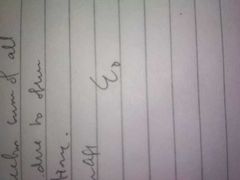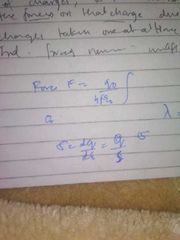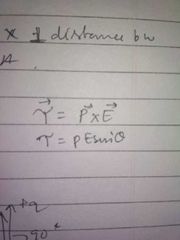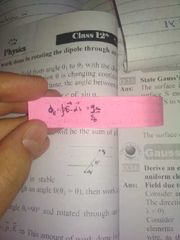![]()
![]()
![]()
Use LEFT and RIGHT arrow keys to navigate between flashcards;
Use UP and DOWN arrow keys to flip the card;
H to show hint;
A reads text to speech;
24 Cards in this Set
- Front
- Back
- 3rd side (hint)
|
Continuous charge distribution |
A system of closely spaced charges |
System |
|
|
Point charge |
Any charge whose dimensions are much less than its distance from the obs point |
|
|
|
1 Coulomb |
Quantity of charge which when placed at a distance of 1m from an equal charge experiences a force of 9× 10^9 N |
|
|
|
Superposition principle |
Consider a system of n stationary charges , individual forces are unaffected due to presence of other charges |
|
|

What is |
Permittivity of vacuum/free space |
|
|
|
What is the value of k in F=kqq/r^2 |
9×10^9 Nm2/C2 |
|
|
|
What is the value of permittivity of free space (Eo)? |
8.854× 10^-12 |
|
|
|
Three charge distributions |
•line charge distribution •surface charge distribution •volume charge distribution |
|
|
|
What is line charge distribution |
When charge is uniformly distributed along a line/edge/circumference, the system is said to be a line charge distribution |
|
|
|
Surface charge distribution |
When charge is uniformly distributed over a surface,the system.... |
|
|
|
Volume charge distribution |
When------- distributed (not necessarily uniform in all cases) throughout a volume |
|
|
|
Line charge density is given by |

|
|
|
|
Surface charge density |

Sigma |
|
|
|
Electric field, definition, SI unit, features: min 3 |
The region surrounding a charge in which it's influence can be experienced by other charges. Field due to charge Q at a point P, is the Force a unit positive test charge would experience at THAT point. SI unit; N/C Source charge(the one producing teh EF) Test charge; which tests the effect of src charge Q must remain at its original location and naturally, test charge<<< src charge EF of positive -radially outward Of negative Electric field at points equidistant from src charge is same |
|
|
|
ELECTRIC FIELD INTENSITY |
at any point is the strength of the EF at that point. E=F/q Force experienced by a unit positive charge placed at that point |
|
|
|
Formula of torque |

Where theta is the angle that dipole moment makes with the direction of EF |
|
|
|
T max |
T max= PE (i.e. when theta is 90°) |
|
|
|
Definition of electric dipole (both numeric awa conventional) |
We know, T max= PE (i.e when DM is perp. to EF) => P= Tmax/E Put E= 1 Newton per coulomb => P= T Electric dipole moment is numerically equal to the torque experienced by the electric dipole when placed perp to an electric field of EFI(electric field intensity) of 1N/C. |
|
|
|
Gauss's law gives the relation between |
Total flux passing through any closed surface and net charge enclosed within the surface. |
|
|
|
Gauss's theorem statement |

The total flux through closed surface is 1/E0 times the charge enclosed by that surface |
|
|
|
Electric flux |
What is it Definition Denoted by Formula Whether scalar or vector SI unit |
|
|
|
Electric flux through a given area |
Held inside an EF is the measure of total number of EFL passing normally through that area. |
|
|
|
Electric flux is a |
Scalar quantity |
|
|
|
Electric flux through any surface |
Is equal to the surface integral to electric field E (vector) taken over the surface S. |
|

